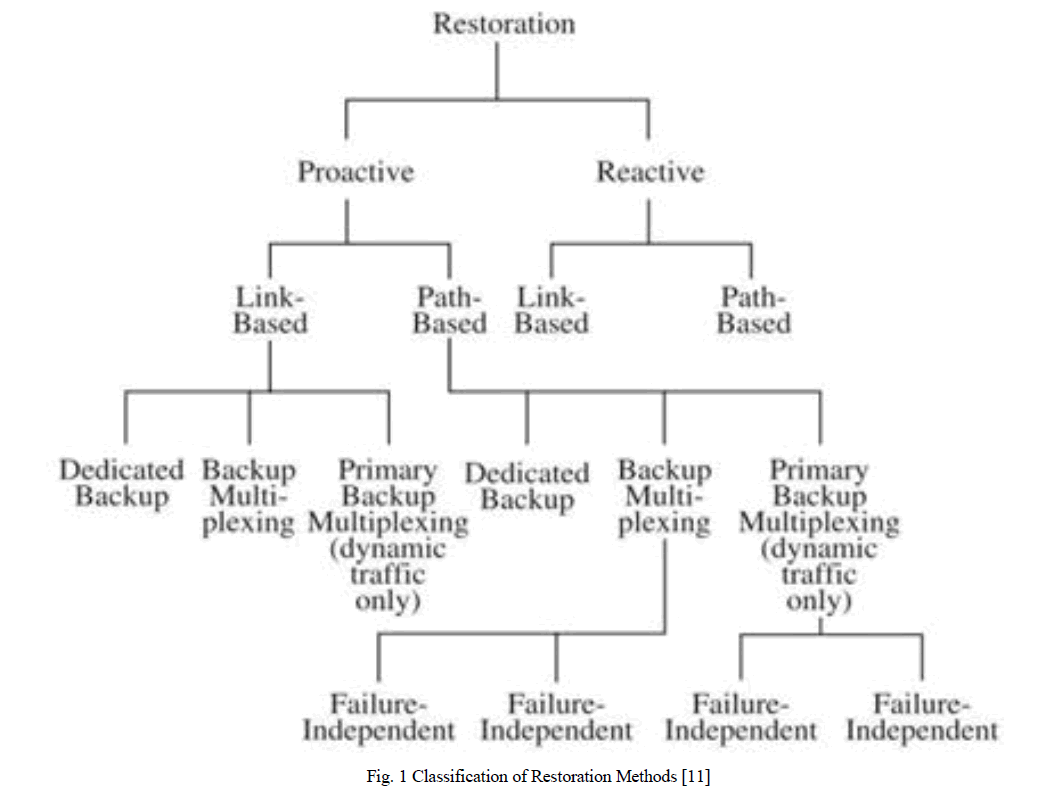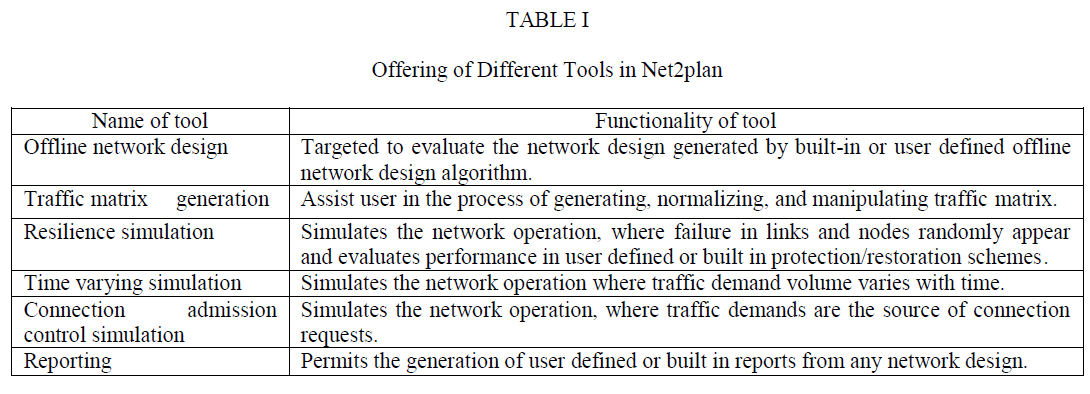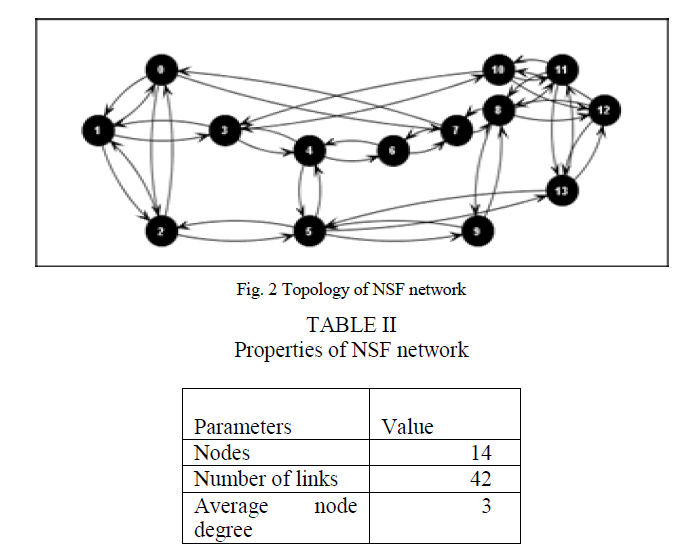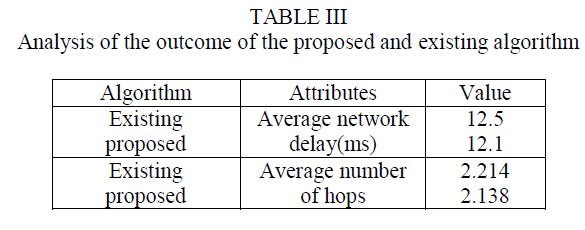ISSN ONLINE(2319-8753)PRINT(2347-6710)
ISSN ONLINE(2319-8753)PRINT(2347-6710)
Krishan Kumar1 and Amit Kumar Garg2
|
| Related article at Pubmed, Scholar Google |
Visit for more related articles at International Journal of Innovative Research in Science, Engineering and Technology
Survivability is one of the most important requirements of optical networks. As optical networks are prone to component failures and carry a large volume of traffic, maintaining a high level of service availability is an important issue. In this paper, existing restoration methods proposed for optical network are critically analysed. A Net2Plan tool is presented, its features and how effectively a problem can be framed and existing and modified algorithms can be implemented on resilience simulation
Keywords |
| Survivability, Restoration, Optical networks. |
INTRODUCTION |
| Optical fiber has become the dominant transport medium in telecommunication systems because its advantage in capacity, reliability, cost and scalability. An attractive feature of optical fiber is its extremely large capacity, on the order of few terabits per second. Optical fiber is widely deployed in backbone networks. Only a small fraction of the full capacity of the installed optical fiber has been realized thus far. Reason for this inefficiency is large mismatch between peak electronic processing and source rates, and fiber capacity [1]. |
| Wavelength division multiplexing network are prone to failure of components such as links, nodes, and wavelength multiplexers and demultiplexers. These network carry high volume of traffic failure may have severe consequences. Therefore, it is imperative that these networks are fault tolerant. Fault tolerant is the ability of the network to reconfigure and re-establish communication upon failure. Incorporating survivability mechanism at multiple layer leads to the issue of assigning functions to each layer and coordinating the layer in effective recovery from fault. optical layer is formed between the lower physical media layer and higher circuit layer in the transport network architecture. This layer is protocol transparent, and can support different kinds of services and protocols at the higher layer such as synchronous optical network (SONET), synchronous digital hierarchy (SDH), asynchronous transfer mode (ATM), and internet protocol (IP). The higher circuit layer is known as client layer [3] because it is served by optical layer. |
| The outline of the paper is as follows. In section II related work and classification of restoration methods has been given. Section III concentrates on network simulator modules and its functions. Analysis of proposed and existing algorithm discussed in section IV. In section V results of modified algorithm are discussed. Finally, concluding remarks are presented in section VI. |
RELATED WORK |
| A. Related work |
| B.T Doshi et al. and S. Ramamurthy and B. Mukherjee [4-5]. A problem of restorable network design for a static traffic demand has been dealt in it. It considers a single fiber networks. Dexiang Wang et al. [6] the work considers the simulation framework for optical local area network, which enables a multi- layer simulation and hence bridged gap between traditional signal level and traffic level simulators. G. Mohan, Siva Ram Murthy [7] considered a single link failure model in their study and recommended the use of a proactive approach; they utilize primary backup multiplexing and conduct extensive simulation in different network and performance of proposed algorithm. D. Zhou and S. Subramaniam [8] they presented a description of different survivability techniques for optical networks both for non-WDM and WDM. Gurusamy Mohan and siva Ram Murthy [9] presented a comprehensive survey related to lightpath restoration in WDM optical networks. |
| B. classification of restoration methods |
| The restoration methods can be classified as in fig.1 they can be broadly classified as reactive and proactive methods. |
 |
| Proactive methods use the protection based approach, While reactive method is simplest way of recovery from failure. However this method does not guarantee successful recovery. In proactive method a backup lightpath are identified and resources are reserved along the backup lightpaths at the initial stage itself. By employing backup resources this method yields 100% restoration guarantee and more faster than reactive technique. This method can be further classified as link based or path based [4-5]. The link based method employs local detouring, while path based method employs end to end detouring. A link-based method reroutes traffic around failed component. When a link fails, a new path is selected between the end nodes of the failed link. This path along with working segment of the primary path will be used as the backup path. In path-based restoration method, a backup lightpath is selected between the end nodes of the failed primary lightpath. Unlike the link based method, in the path-based method a backup lightpath need not retain the working segment of the primary lightpath. This shows better resource utilization. A proactive may use a dedicated backup lightpath for primary lightpath. This is known as dedicated backup (DB) reservation method. This method has advantage of shorter restoration time, since wavelength cross connects configured for the backup path when establishing the primary path itself. Better resource utilization, multiplexing technique can be employed. If the two primary lightpaths do not fail simultaneously, their backup lightpath backup lightpath can share a wavelength channel. |
| This technique is known as backup multiplexing. In dynamic traffic scenario, a proactive method can employ primary backup multiplexing. To further improve resource utilization. A path based restoration method is either failure dependent or failure independent. Failure dependent method is associated with the failure of every link used by a primary lightpath. There is a backup lightpath. As when primary link fails its corresponding backup path is used. In a single link failure different backup lightpath of a primary lightpath can share a channel. In a failure independent method a backup lightpath is chosen in such a way as it is link- disjoint with the primary lightpath. |
NET2PLAN SIMULATOR FOR PERFORMANCE ANALYSIS |
| Net2plan is a technology agonistic open source java tool devoted to the planning, optimization and evaluation of communication networks. Moreover, report generation and post analysis simulation tools integrated in Net2plan help one to get into the network design merit. |
| A. A Subset of configurable parameters in the network simulator |
| Net2plan different modules and channels these can be change as demand of user, technology specific information can be introduced in the network representation via user defined attributes. Configurable parameters are nodes, links, traffic demand, routes, protection segment, shared risk group |
| B. Different tools provided by Net2plan |
| Net2plan is implemented as java library along with command line and graphical user interfaces. This tool is intended for broad spectrum of users, Net2plan provides six different tools. |
 |
ESTABLISHMENT OF RESTORATION MECHANISM |
| Failure in links and nodes appear randomly according to user defined availability information of the network nodes and links. Allow testing built-in or user made provisioning algorithms that react to failure reparation events from an initial network design. As shown in fig.2 topology of realizable national science foundation network (NSF) |
 |
| Average node degree is defined as the ratio between the number of links and the number of nodes in the network. above said topology is used to implement existing and NRSim_AA_MPLS_fastReroute restoration each route is tried to restore upon a failure at the node immediately up. This node which redirects the traffic onto the backup path is called the point of local repair and the node downstream where the backup path re-joins to the primary path is called merge point. The proposed modified algorithm NRSim_AA_MPLS_fastReroute_modified based on the principle modification as the reroute mechanism, used in this case is path based rerouting. All the modifications in the java code is done in eclipse java development tool and java run time environment is must to make modifications. Both algorithms implemented in above stated NSF topology. |
RESULTS AND DISCUSSION |
| Simulation report shows availability statistics collected by the kernel and also those collected by the provisioning algorithm. Table III shows the analysis of the outcome of the proposed and existing algorithms. Average number of delay is defined as the end-to-end delay suffered by the packet chosen randomly in the network. Average number of hops represents the ratio between the in-network traffic (total sum of the carried traffic in all links) and the total carried traffic. The average network delay provided by the modified algorithm is narrowly better than the existing algorithm. It is due to approach adopted in the modification of the algorithm as the path based rerouting technique. Attribute number of hops is also somewhat better than existing algorithm. |
 |
CONCLUSION AND FUTURE SCOPE |
| It is vital to develop appropriate survivability mechanism in optical networks. In this paper classification of protection and restoration method and simulation framework based on Net2plan simulator is presented. Analysis of existing and modified rerouting algorithm is done. It is found that path based modification done in the algorithm changed few attributes and are critical for long run less time delay in networks. Still a lot needs to be done in intelligent and efficient routing and restoration. |
References |
|